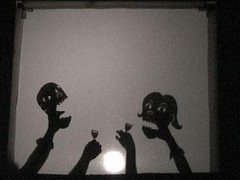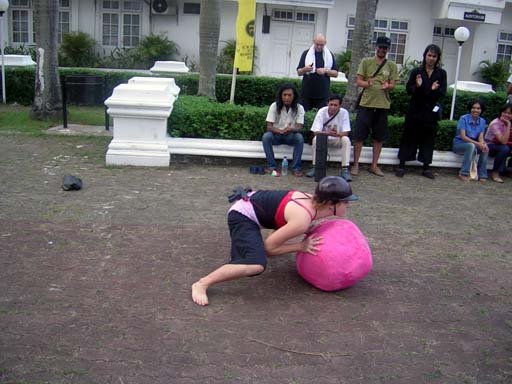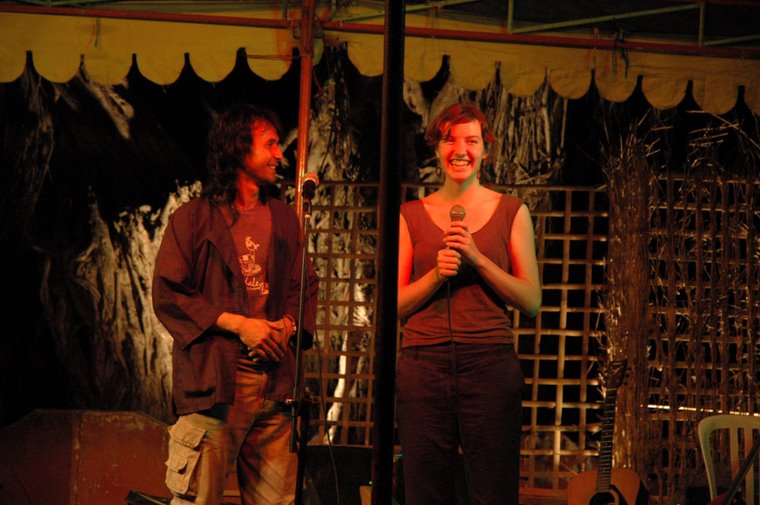
At 6am on May 27th, 2006, Yogyakarta was hit by a very large, tectonic earthquake, claimed by various sources to be from 5.9 to 6.3 in Richter scale, with over 6,000 people killed, 15,000 injured and 30,000 homeless. The village where I live, Sewon, Bantul, was one of the most badly hit. From here to the south until the ocean, villages that once stood were totally smashed to the ground, families were forced to live in tents, all their belongings destroyed, schools shut down, everything stopped in mid-sentence, shaken to a reality that no-one would ever expect to happen, but did.
It’s amazing and totally eye-opening to see how everything can be regular one minute, and totally different the next. Buildings on the roads you’re used to passing, homes of friends you’re used to going to, the night spots you usually hang out, even your school, all of them gone in just 30 seconds.
After the earthquake, Yogya was a combination of chaos and complete silence. Bricks and cement strewn everywhere, mobs of people fleeing in panic to the north in fear of a tsunami (which did happen, but a month later and a totally different earthquake, the biggest center in West Java, but reaching all the way to the beach 40 minutes south of Yogya), families still searching for their loved ones beneath the rubble, huddled together at night in the pouring rain, nowhere to sleep, scared of aftershocks, no food to be found anywhere.
nowhere to sleep, scared of aftershocks, no food to be found anywhere.
Miraculously, my home survived the quake with only a few small cracks and smashed things inside. Not to say that I wasn't scared to sleep inside, several times being woken up by aftershocks and with impulsive instinct immediately running outside. One thing that an earthquake will do is give you this intense awareness of space. I’ve never paid such close attention to where I am, whether the space is dangerous or not, and how to get out quickly if things start to shake again.
Since I arrived in Yogya, I met and began collaborating with a tight community of artists called Taring Padi, which means the sharp tooth of the rice paddy. Taring Padi is a collective of tattooed, incredibly creative, talented artists who for years have been creating artwork and living together, much of their art focusing on social/political issues, ranging in a variety of forms which include but are not limited to painting, wood-block cutting, screen-printing, performance art, sculpture and music. Since the earthquake, Taring Padi also became a victim, it’s community home and workspace as well as the homes of several members completely smashed. Thus, the community space of Taring Padi was forced to move to a small tent and re-establish itself like all the other earthquake victims. Despite it’s own inconvenience, Taring Padi became involved with helping others, the first two weeks gathering food and goods that were not easily accessible (such as rice and vegetables, baby milk, tents, blankets, medicine, etc.), and distributing it to those in need. After two weeks, we decided to refocus our work more on the long-term, gathering donations from outside of Indonesia (managing to raise about $15,000, $5,000 of which came from my dear friends and family in America), and setting up a few different programs aimed at re-establishing what had been lost from the earthquake. These programs include; buying land for Taring Padi to establish a permanent place for its collective of artists and the community close-by, starting an alternative arts workshop program for children to be run in several villages that were badly hit by the quake, and distributing money to families who had lost their homes, to assist in rebuilding a new place to live.
those in need. After two weeks, we decided to refocus our work more on the long-term, gathering donations from outside of Indonesia (managing to raise about $15,000, $5,000 of which came from my dear friends and family in America), and setting up a few different programs aimed at re-establishing what had been lost from the earthquake. These programs include; buying land for Taring Padi to establish a permanent place for its collective of artists and the community close-by, starting an alternative arts workshop program for children to be run in several villages that were badly hit by the quake, and distributing money to families who had lost their homes, to assist in rebuilding a new place to live.
My main focus was with the arts workshop program for children. We focused on two different villages, with a third one of more permanent status (in Taring Padi’s new home), which is currently in the beginnings of being developed. The goal of the workshops was to provide children in the villages with an outlet to express and relieve their traumas from the earthquake, to get away from their smashed homes and learn about different forms of art, allowing inspiration and creativity to continue to flow. Over a span of approximately six weeks in each village, in which the children numbered to about 90 from ages 4 to 12, we taught workshops in drawing and painting, creating mozaics, playing music, and performance and mask-making, the final meeting culminating a carnival of masks and music created by the children, which involved parading through their village and sharing their art and creative energy with their families and community members. The most amazing thing working with these children was how the smiles on their faces for the most part never seemed to disappear, still full of fresh thoughts and ideas, anxious and excited to learn, and continuously hopeful and positive about the future.
still full of fresh thoughts and ideas, anxious and excited to learn, and continuously hopeful and positive about the future.
In the end, although this experience was challenging, difficult, and frightening and to this day still continuing (the earthquakes and natural disasters don’t seem to stop in Indonesia), it has been an experience which has completely changed my point of view about life, people, and the situations that always have the possibility to come but in day-to-day life don’t usually surface. It has given me an even stronger appreciation of the people I care about, the friends that I have, the children whose ideas and inspirations continue to flow, and how art and community can always establish a sense of safety, belonging, and the possibility of creating something that has a positive effect for all those involved.
a positive effect for all those involved.
It’s amazing and totally eye-opening to see how everything can be regular one minute, and totally different the next. Buildings on the roads you’re used to passing, homes of friends you’re used to going to, the night spots you usually hang out, even your school, all of them gone in just 30 seconds.
After the earthquake, Yogya was a combination of chaos and complete silence. Bricks and cement strewn everywhere, mobs of people fleeing in panic to the north in fear of a tsunami (which did happen, but a month later and a totally different earthquake, the biggest center in West Java, but reaching all the way to the beach 40 minutes south of Yogya), families still searching for their loved ones beneath the rubble, huddled together at night in the pouring rain,
 nowhere to sleep, scared of aftershocks, no food to be found anywhere.
nowhere to sleep, scared of aftershocks, no food to be found anywhere.Miraculously, my home survived the quake with only a few small cracks and smashed things inside. Not to say that I wasn't scared to sleep inside, several times being woken up by aftershocks and with impulsive instinct immediately running outside. One thing that an earthquake will do is give you this intense awareness of space. I’ve never paid such close attention to where I am, whether the space is dangerous or not, and how to get out quickly if things start to shake again.
Since I arrived in Yogya, I met and began collaborating with a tight community of artists called Taring Padi, which means the sharp tooth of the rice paddy. Taring Padi is a collective of tattooed, incredibly creative, talented artists who for years have been creating artwork and living together, much of their art focusing on social/political issues, ranging in a variety of forms which include but are not limited to painting, wood-block cutting, screen-printing, performance art, sculpture and music. Since the earthquake, Taring Padi also became a victim, it’s community home and workspace as well as the homes of several members completely smashed. Thus, the community space of Taring Padi was forced to move to a small tent and re-establish itself like all the other earthquake victims. Despite it’s own inconvenience, Taring Padi became involved with helping others, the first two weeks gathering food and goods that were not easily accessible (such as rice and vegetables, baby milk, tents, blankets, medicine, etc.), and distributing it to
 those in need. After two weeks, we decided to refocus our work more on the long-term, gathering donations from outside of Indonesia (managing to raise about $15,000, $5,000 of which came from my dear friends and family in America), and setting up a few different programs aimed at re-establishing what had been lost from the earthquake. These programs include; buying land for Taring Padi to establish a permanent place for its collective of artists and the community close-by, starting an alternative arts workshop program for children to be run in several villages that were badly hit by the quake, and distributing money to families who had lost their homes, to assist in rebuilding a new place to live.
those in need. After two weeks, we decided to refocus our work more on the long-term, gathering donations from outside of Indonesia (managing to raise about $15,000, $5,000 of which came from my dear friends and family in America), and setting up a few different programs aimed at re-establishing what had been lost from the earthquake. These programs include; buying land for Taring Padi to establish a permanent place for its collective of artists and the community close-by, starting an alternative arts workshop program for children to be run in several villages that were badly hit by the quake, and distributing money to families who had lost their homes, to assist in rebuilding a new place to live.My main focus was with the arts workshop program for children. We focused on two different villages, with a third one of more permanent status (in Taring Padi’s new home), which is currently in the beginnings of being developed. The goal of the workshops was to provide children in the villages with an outlet to express and relieve their traumas from the earthquake, to get away from their smashed homes and learn about different forms of art, allowing inspiration and creativity to continue to flow. Over a span of approximately six weeks in each village, in which the children numbered to about 90 from ages 4 to 12, we taught workshops in drawing and painting, creating mozaics, playing music, and performance and mask-making, the final meeting culminating a carnival of masks and music created by the children, which involved parading through their village and sharing their art and creative energy with their families and community members. The most amazing thing working with these children was how the smiles on their faces for the most part never seemed to disappear,
 still full of fresh thoughts and ideas, anxious and excited to learn, and continuously hopeful and positive about the future.
still full of fresh thoughts and ideas, anxious and excited to learn, and continuously hopeful and positive about the future.In the end, although this experience was challenging, difficult, and frightening and to this day still continuing (the earthquakes and natural disasters don’t seem to stop in Indonesia), it has been an experience which has completely changed my point of view about life, people, and the situations that always have the possibility to come but in day-to-day life don’t usually surface. It has given me an even stronger appreciation of the people I care about, the friends that I have, the children whose ideas and inspirations continue to flow, and how art and community can always establish a sense of safety, belonging, and the possibility of creating something that has
 a positive effect for all those involved.
a positive effect for all those involved.





























No comments:
Post a Comment